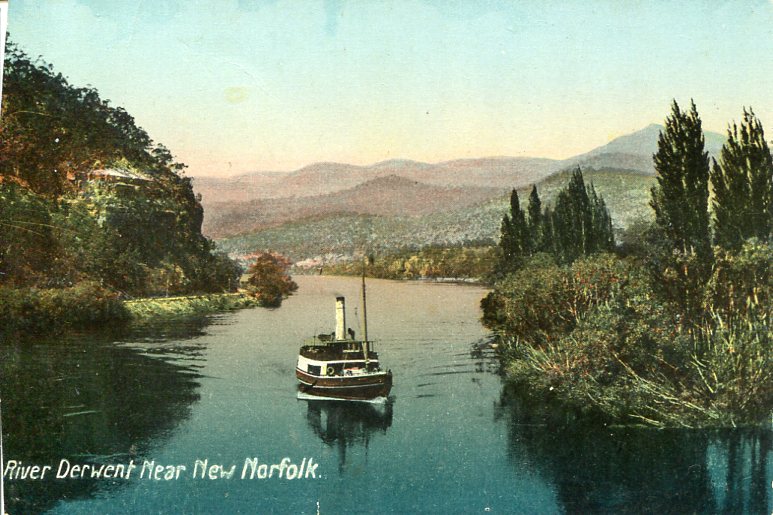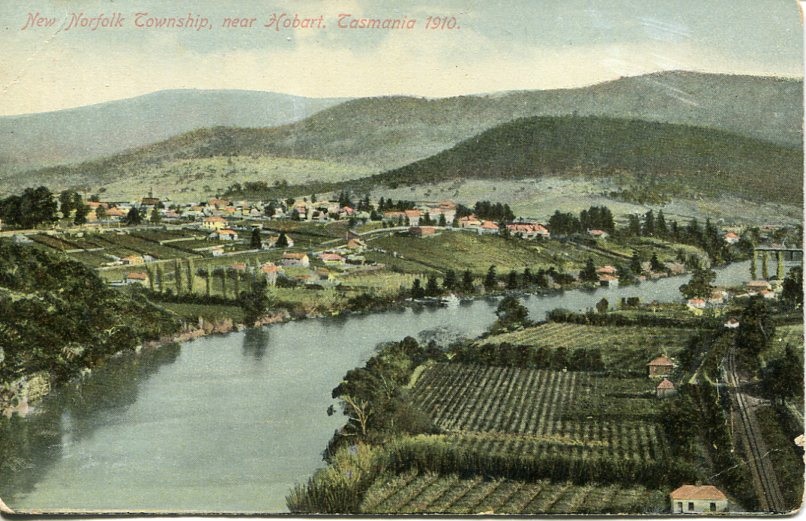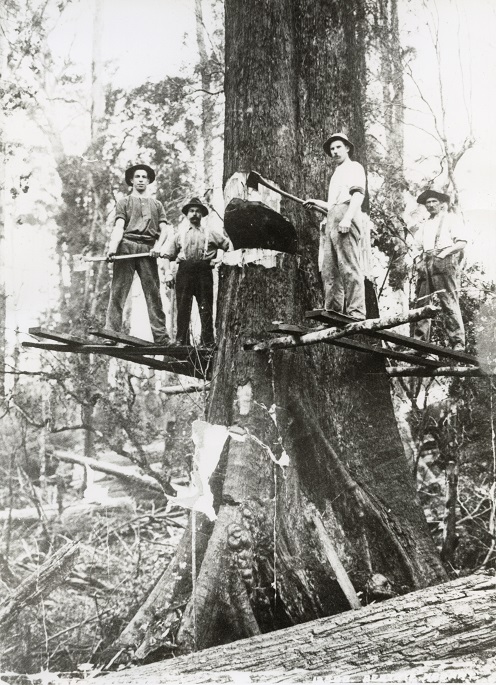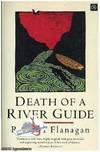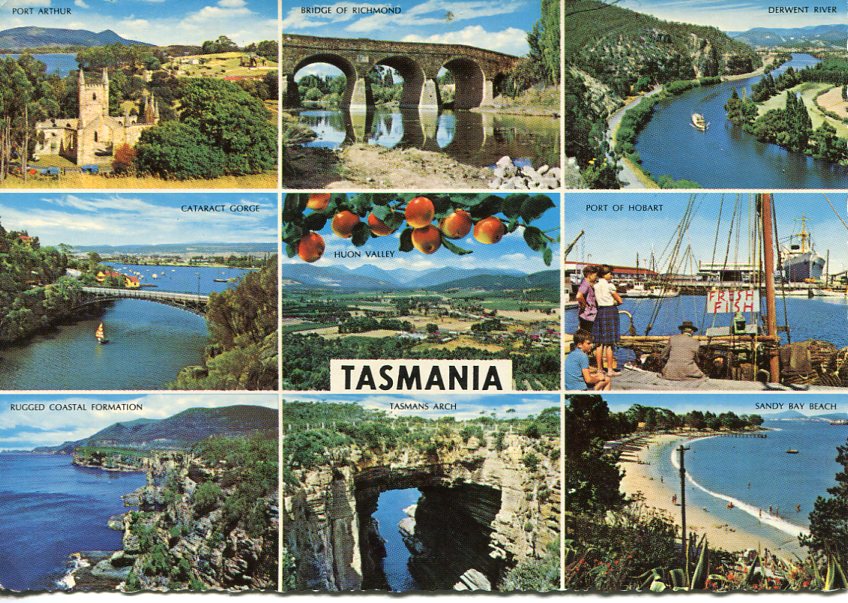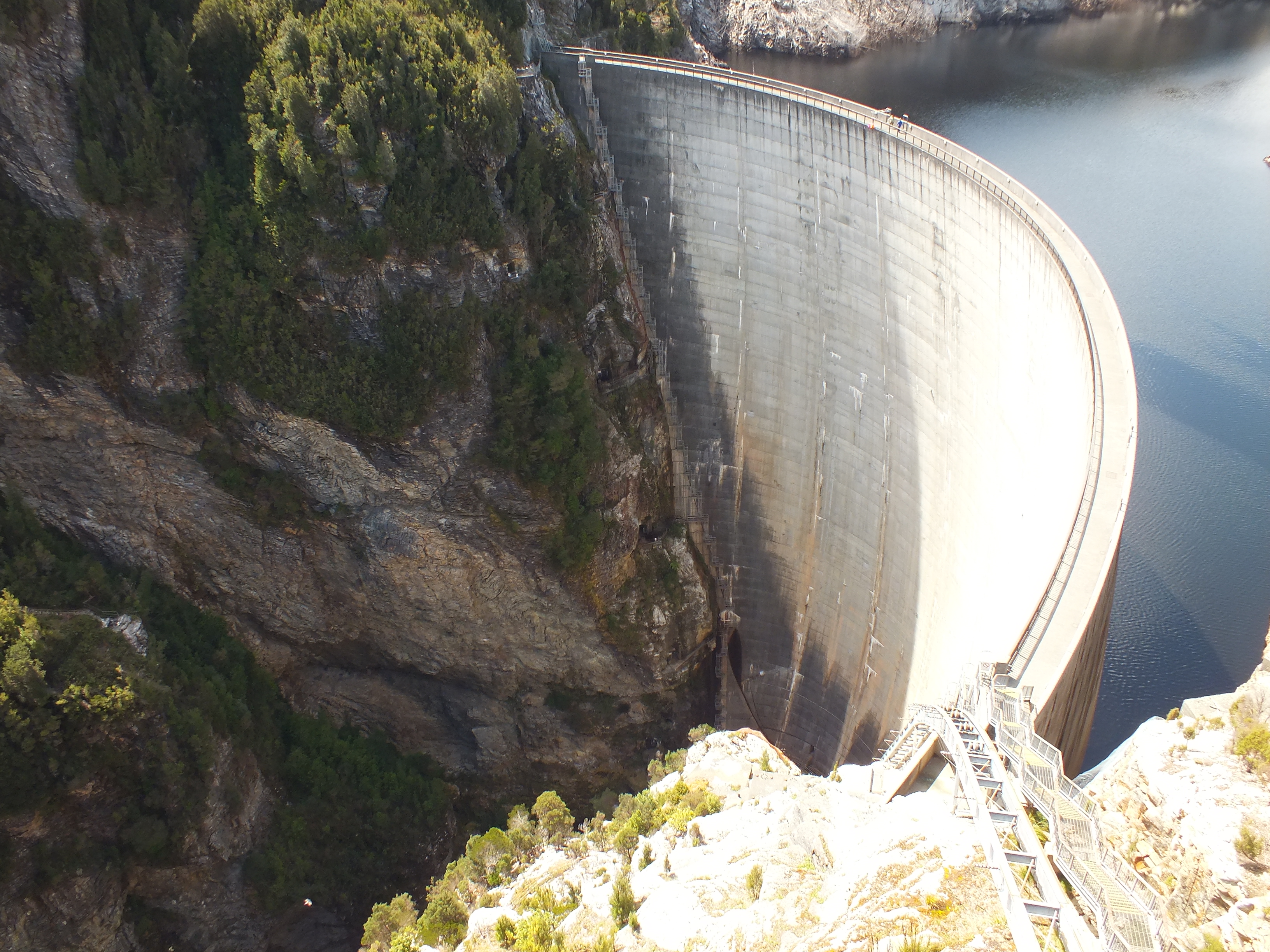AustLit
-
To cite Mark Twain again, thinking about Hobart, Van Diemen’s Land history, and landscape, he is drawn to Mount Wellington/kunanyi:
...a stately bulk a most majestic pile. How beautiful is the whole region, for form, and grouping and opulence and freshness of foliage, and variety of color, and grace and shapeliness of the hills, the capes, the promontories; and then, the splendour of the sunlight, the dim rich distances, the charm of the water-glimpses! And it was in this paradise that the yellow-liveried convicts were landed, and the Corps-bandits quartered, and the wanton slaughter the kangaroo-chasing black innocents consummated on that autumn day in May, in the brutish old time. It was all out of keeping with the place, a sort of bringing of heaven and hell together. (281)
Once again, Twain was alert to a deep structure within Tasmanian culture inaugurated at its founding: it’s radical ambivalence, its doubleness, its bipolar mentality. Twain’s response of Tasmania as both heaven and hell is all the more percipient given that he had no first-hand experience of the binary geography of the island. He only encountered the ‘paradise’ of the Hobart-Derwent settlement, having sailed down the eastern side of the island, a sunny, fertile extension of Wilson’s Promontory. Twain didn’t see the western side, a wild, Southern Ocean-lashed wilderness of sparse or abandoned settlements – he saw Wineglass Bay rather than Hells Gates.
-
Giles Deleuze’s analogy of the insular imagination in relation to island geomorphology echoes Twain’s binary perception:
...everything that geography has told us about […] islands, the imagination knew already on its own and in another way. The élan that draws humans toward islands extends the double movement that produces islands in themselves. Dreaming of islands – whether with joy or in fear, it doesn’t matter – is dreaming of pulling away, of being already separate, far from any continent, of being lost and alone – or it is dreaming of starting from scratch, recreating, beginning anew. Some islands drifted away from the continent, but the island is also that towards which one drifts; other islands originated in the ocean, but the island is also the origin, radical and absolute. (10)
Ambivalence, of course, is not peculiar to Tasmanian landscape and culture. F.G. Clarke, for instance, characterised the historiography of British colonial settlement in Australia, generally, as about British attitudes to a land of contrarieties (The Land of Contrarieties: British Attitudes to the Australian Colonies 1828-1855 [Melbourne UP, 1977]). Nevertheless, the distinctive kinds of doublings, oppositions and contrarieties across and, often, within a whole range of Tasmanian literary and cultural expressions have a compelling pattern to them. The name of Wineglass Bay is perhaps an apt symbol of this complex ambivalence, with its now invisible contradictions of landscape and historical amnesia. Innumerable tourist shots today suggest the name Wineglass refers only to the sunny, pristine circularity of the bay when in fact it refers to the appearance of a glass of red wine, from the days when the local whaling station filled the bay with blood.
-
Matthew Kneale’s novel English Passengers (2000), narrated by 20 different characters, including a Manx sea captain (Illiam Quillian Kewley), an Anglican vicar (the Reverend Geoffrey Wilson), the proto-fascist taxonomer of race Dr Thomas Potter (a fictional version of Robert Knox, author of The Races of Men: a Fragment, 1850, for whom races were species) and a Tasmanian Aboriginal (Peevay) is the story of an 1850s sea voyage to Tasmania. Wilson, obsessed with a myth that goes back to Sir John Mandeville, believes Tasmania is the site of the Garden of Eden: ‘One of the four rivers that I had identified as being mentioned in Genesis was the Derwent (aboriginal name Ghe Pyrrenne: Euphrates), which was the very waterway that flowed past Hobart. What could be simpler! If we followed this as far as its source we must eventually find ourselves looking upon Eden’ (318). Wilson is in search of ‘a Christian significance for this wild land’ (321). Potter, by contrast, whose sections in the narrative often take the form of drafts or notes towards his The Destiny of Nations, is sailing in expectation of discovering scientific evidence of the racial inferiority of the Aboriginals – ‘the dominating characteristic of the Black type being barbarism’ – and of collecting ‘specimens in the wilderness’ (406; 348). Thus the narrative is shaped by this central (comic) dialectic of the delusions of mid-19th-century religion and science, both focused on Tasmania as simultaneously a Garden of Eden and a pseudo-evolutionary backwater. Potter suffers the same fate as the Macquarie Harbour commissary and diarist Lemprière in Flanagan’s Gould's Book of Fish. Both craven abettors of a racist European scientific paradigm, Potter’s and Lemprière’s own osteological and cranial remains end up on display in English exhibits of ‘inferior’ racial specimens. Peevay’s narrative stands to the side of this double delusion. The novel also includes a transcription of a letter from the Archives Office of Tasmania about the education of the Aboriginal boy George Vandiemen in Lancashire (see 457-58).
Other narratives that evoke a utopian or paradisal image of Tasmania include Eleanor Alliston’s (1913-2003) accounts of her own and her family’s Swiss Family Robinson-like life on Three Hummock Island, in the Western Bass Strait, from their arrival in 1951, the memoir Escape to an Island (1966) and the slightly fictionalised Island Affair (1984). The Adelaide-born Eleanor and her English naval captain husband Commander Alliston escape the dismal wreck of post-war England in search of a new life in a remote colony, driven by the romance of the open road and the desert island: ‘we intended to buy a horse caravan in which to tour the country and to find the ideal settlement for ourselves at our leisure’ (3). Alliston exploited her sense of Tasmania as the site of romance even further with her Mills and Boon novel Master of Bucklands (1988), published under the pen-name Minka Jones. One critic has drawn attention to this particular kind of attraction of islands for the English sensibility, exemplified latterly by Richard Branson’s ownership of Necker island, one of the British Virgin Islands, ‘It was the brightest jewel I’ve ever found’ (see McMahon, ‘{{The Gilded Cage}}'(C760582)). Branson seems like a real-life version of D.H. Lawrence’s ‘Man Who Loved Islands.’ Anne Shimmins’ novel Eden Observed (1999) is also set on one of the Bass Strait islands (unnamed but probably King Island) but, as the flipside to Alliston’s island idyll, it is a Dantesque allegory of love in hell (see Cranston ‘Islands’).
Martin Ball, in a reading of the Tasmanian-born composer Peter Sculthorpe’s String Quartet No. 14 (1998), notices the last movement, entitled ‘Quamby Bluff,’ in relation to the geography of central Tasmania: Quamby Bluff ‘forms part of the huge buttress of the Great Western Tiers in the centre of the island. At the foot of the Bluff, gentle pastures and arable land spread north and east. Behind spreads the vast uninhabited wilderness of South-West Tasmania. Janus-faced, Quamby Bluff expresses the two dominant readings of Tasmanian landscape: utopian pastoral versus Gothic horror’ (Ball 119). In the same locale Nan Chauncy’s Tangara also reflects this dichotomy of landscape and history with its time-slip narrative of a young white girl, Lexie, at the old Midlands property ‘Wanderon,’ beneath Quamby Bluff. In the time-slip she meets an Aboriginal girl, Merrina, from ‘Black’s Gully,’ a site of Aboriginal ochre mines, but also the site of settler reprisal killings of the Pallittorre people in June 1827. Historian Shayne Breen describes this territory as a ‘place of paradoxes,’ an ancient place with the superficial appearance of agricultural prosperity, but overlaid by immigrant cultures of radical environmentalism, dispossessed Aborigines, and New Agers (xiv). These seemingly innocent Midland and Northern districts also provide the setting for novels like Catherine Jinks’ The Rapture (2001) and Carmel Bird’s Cape Grimm (2004), both narratives about religious and missionary extremism within ‘dark’ landscapes, where the characters can flee ‘the evil teachings of false prophets’ (Jinks 22).
-
The many narratives of Tasmania’s environmental value, from Bob Brown’s several books on Farmhouse Creek, Lake Pedder, the Tarkine, and Valley of the Giants to Peter Hay’s Vandemonian Essays (Walleah 2002) and including perhaps most influentially Richard Flanagan’s Death of a River Guide (1994), are contrasted by novels like James McQueen’s Hook's Mountain (1989) and Brian Castro’s Drift (1995). McQueen’s novel of a returned soldier looking for pastoral solace in Tasmania’s north-east describes Hook’s transformation into an ecological commando fighting against the incursions of loggers and monocultural plantationists. The novel seems far from environmentalist in its values with its depiction of Hook as a kind of remote Tasmanian member of Edward Abbey’s ‘Monkey Wrench Gang.’ It nevertheless played a real-world role in the temporary cessation of logging of Blue Hill at Nabowla (see Cranston 62; McQueen, ‘Hook's Country,’ Overland 98 [April 1985]: 35-8). One of Castro’s narrators in Drift, Tom McGann, an ‘Aboriginal other’ as Castro calls him, notices the madness in the name Tasmania (84): an observation that seems to point to the narrative’s kaleidoscopic intercalation of episodes from Tasmanian history (like Pearce’s cannibalism) and iconic landscapes (like Cape Grim and muttonbird islands) into the space of the experimental English novelist B.S. Johnson. This tasmanic juxtaposition of voices from beyond the grave articulates Castro’s ‘lament for the genocide of the Aboriginal people of Tasmania’ as ‘embodied by B.S. Johnson, an English writer who committed suicide in 1973’ (Castro, Looking for Estrellita 119-20).
-
The first-person narrator of Flanagan’s Death of a River Guide, Aljaz Cosini, begins his story with his birth in Trieste. Aljaz’s mother Sonja is a refugee from post-war Soviet Yugoslavia, where she meets his father Harry Lewis, a Tasmanian sewing machine salesman. The framing irony of the story is established with Aljaz’s birth ‘within the caul’ and a life that will end with his drowning on the Franklin River. In the novel-long moment of drowning, Aljaz has a bird’s-eye or spectator’s view of his own life, as the involuntary visions and flashbacks pass before his eyes and the revelations about his own identity unfold: ‘I can see all these things in my visions, including myself in days gone by’ (39). These visions include the progress of a rancorous group of river guides and ‘punters’ on their rafting trip down the Franklin, the history of his part-Aboriginal father Harry Lewis, descended from an Aboriginal woman, ‘Black Pearl’ and a Bass Strait sealer, Harry’s life among the west-coast piners in the 1930s, Aljaz’s love story with Couta Ho and the tragedy of their daughter Jemma’s death, the story of cannibal and murderer Ned Quade, another ancestor, at the Macquarie Harbour convict settlement, the ‘greenie camp’ in Strahan during the Franklin Blockade (‘these are not my people’ [253] he thinks), and finally, a time-lapse vision of the geological history of the Tasmanian landmass: ‘I saw the earth bulge up into mountains, saw plants flowering, some large and dramatic, and cover the earth. Saw ice and snow form over much of the land, and the rainforest retreat into the lowest and warmest valleys. Saw giant wombats bigger than a man, and huge kangaroos and monster emus arrived. Saw people and their truth of fire arrive’ (323). In the end, Aljaz’s life is a panorama of edited moments and disjuncts – Black Pearl holding Jemma – as his consciousness seems to enter into that of a rising sea-eagle that ‘carries the spirits’ of his Aboriginal-Slovenian-Celtic family and ancestors into the sky (326). It is as if Tasmania is this river guide’s nation, going back to the etymological root of natio, the site of shared ancestry, the place where a people of mixed race and ethnicity is born. While the south-west wilderness and other regions of Tasmania, including Hobart, are a vivid presence throughout the novel, they are not thematic. The novel’s islescape is simultaneously spiritual and disenchanted. It’s the geological timescale and non-human sublime that provide Flanagan’s perspective. Man has an Anthropocentric presence, even in the south-west wilderness, but his environmental values seem ephemeral and limited.
-
Bessie Marchant (1862-1941), ‘the girl’s Henty,’ was a hugely prolific author of stories for both girls and boys, with over 150 titles. Many of her stories are set overseas, despite the fact that the author herself never left Britain. She drew her knowledge of exotic locations from visits to the Bodleian Library and studying the Geographical Magazine, and through correspondence with readers in different countries. Marchant's two ‘Tasmanian’ novels are The Apple Lady (1908) and Sally Makes Good : A Story of Tasmania (1920). In Sally Makes Good there is a ‘mongrel set’ descended from the ‘original natives and escaped convicts’ roaming around the west coast, along with iguanas (157). In The Apple Lady two characters make an overland journey from Port Davey to the slopes of Mount Picton. In reality, such a trek through rugged south-west Tasmania would take several days. Marchant's protagonists, however, accomplish the walk in a few hours, before spending the night at the town of Craycroft. This presumptive settlement provides a clue to Marchant's source material. Maps of Tasmania published in Walch's Almanac, accessible to the author through the Bodleian, do not distinguish between established towns and proposed (or gazetted) settlements. One of these ‘paper towns’ is Cracroft. The Almanac map also contains limited topographical details, probably leading Marchant to suppose that the south-west wilderness presented an easy prospect for a ramble. This inventive use of a broad range of textual source material in order to construct particular locations makes Bessie Marchant an interesting example of an early ‘virtual tourist.’
Nevil Shute (1899-1960) also set his aeronautical narrative The Rainbow and the Rose (1958), written after he emigrated to Australia, in the south-west corner of Tasmania. Although, unlike Marchant, Shute did make a journey to Port Davey in 1953, aboard his friend Sir Guy Wyatt’s yacht ‘Saona.’ Whether he noticed Critchley Parker’s grave and headstone at the foot of Mt McKenzie, or even went ashore, remains a mystery. The narrative seems to draw on details from Shute’s travels to other places in Tasmania. It is a tangled story of romance, adultery and suicide against the background of war pilots, flying schools and civil aviation, told in one of Shute’s strained dream visions (like the one in his 1953 novel of Carpentaria, In the Wet) where one pilot recalls the life of another, his mentor. The outer frame is about the rescue of the chief protagonist, Johnnie Pascoe, from a disastrous flight Pascoe has made to rescue a sick girl in mountainous south-west Tasmania. For both these outsider writers, Tasmania is a kind of blank canvas on which to project their narratives, although using details from distant research and short visits; the point, though, is that these fictions, while set in Tasmania, show no sign of the atmosphere and weight of either Vandemonian history or gothic Tasmaniana. These authors can play with Tasmanian place and history from a distance.
-
Dennis Altman’s autobiography of 1997, Defying Gravity : A Political Life includes a first chapter about growing up and leaving Tasmania and is prefaced with an epigraph about the ambivalence of island life – ‘excellent and poor’ – from David Guterson’s Snow Falling on Cedars (7). Altman’s parents, World War II European refugees, came to Tasmania in 1950 because of his father’s job with the Hydro Electric Commission. As Altman writes, ‘[i]t is hard for outsiders to understand the dominance of the Hydro in the Tasmania of the 1950s and 1960s, a product of successive governments’ gamble that the only economic future for Tasmania lay in the potential for industry attracted by cheap electricity’ (11). Later in the chapter, in the context of mentioning his response to Tasmanian writers like James McAuley, Gwen Harwood, Carmel Bird, Amanda Lohrey and Christopher Koch, Altman makes the point that he is not convinced by the myth of Tasmanian exceptionalism: ‘[t]o me Tasmania represents a particular version of Australia which has failed to grow or change as fast as most of the mainland.’ Although, as the history of the Hydro makes clear, it’s not for want of trying. The setting of a futuristically independent Tasmania for Altman’s novel The Comfort of Men (1993) was intended to represent ‘an old Australia resistant to the changes of the 1960s’ (20). The novel begins with Tasmania celebrating its independence from Australia in 1971 – the ‘new Dominion of Tasmania’ – against a background of global unrest in Vietnam, Rhodesia and the Soviet Union. But as the name of this new country suggests, a ‘dominion,’ it has only broken away from the federation of Australia and remains foundationally loyal to England, the English queen and the British Commonwealth. This narrative is a good example of the way in which Tasmania can be used as mise-en-abyme, as micro-nation, as extreme Australia, something that Altman’s critics, missing the social imaginary of dys/utopia generics, tended not to recognize. They accused Altman of ignoring the real-world of the present (the 1990s) and the liberation struggles that were underway in Tasmania in the 1970s, particularly in the cause of gay rights. Whereas what Altman was doing was concentrating late pre-Whitlam Australia into a political and social miniature. The Dominion of Tasmania’s new Prime Minister, van Gelder, outlines his vision of a new and independent Tasmania: ‘a society held together by respect for the eternal verities of the Bible and the British way of life, untouched by the disintegration and assaults of the modern world’ (2). This makes escape from the island all the more imperative for Altman’s first-person protagonist Steven, although the action of the novel keeps coming back to Tasmania, as does Steven, after 20 years. Altman’s point about Tasmanian ‘exceptionalism’ in Defying Gravity is no doubt, at least partially, in response to the critical reception of his novel.
-
As Altman’s family, literary and intellectual origins suggest the Hydro has an influential and ambivalent role in Tasmanian social and political history. Richard Flanagan’s The Sound of One Hand Clapping (1997; movie 1998) is also a 1990s reassessment of what the Hydro meant in human and historical terms but from a very different perspective to Altman’s. The Hydro-Electric Commission had begun in 1930 with some visionary engineering projects and, during the quarter century after the end of the Second World War, the ‘Labor governments of Cosgrove and (‘Electric Eric’) Reece made hydro-electricity’ and specialised secondary industry into symbols of Tasmania. ‘Between the opening of Tungatinah Power Station in 1953 and the opening of Poatina in 1963, seven power stations were opened’ (Lupton 8). The Hydro became a state-wide institution that aimed to define Tasmania as the ‘greatest hydro-electric state in the commonwealth’ and an industrial utopia of the southern hemisphere that would attract industry with its ‘ideal climate, deep water ports, cheap factory sites, abundant fresh water supply’ and the ‘master-key to industry’ hydro-electric power (Lupton 117). Roger Lupton’s history of the Hydro is titled Lifeblood. For a brilliant snapshot of this version of Tasmania, in touristic mode, see J.M. Bale (dir.) The Other Face of the Island (Tasfilm and Department of Film Production, 1970) about Tasmania’s hydro-driven textile, paper, zinc refining, and timber industries. This film portrays the utopian vision of this period in the state’s history culminating in its conclusion about Tasmania’s contribution to the Apollo 11 moon landing and the modern space age. The ambivalence is obvious too: the Tasmanian space age is counterpointed with scenes shot in a disused corner of the mental asylum at Willow Court, New Norfolk.
-
The Other Face of the Island (1970)
https://www.youtube.com/embed/2BebeR55Fdk?rel=0 -
A similar ambivalence about industrial Tasmania is evident in Peter Conrad’s meditation on Wolfgang Sievers’ photographs, like ‘Sulphuric Acid Plant, E.Z. Industries, Hobart 1959,’ which is in fact a gleaming, cleaned up version of the refinery that Conrad lived next to as a child. For Conrad the E.Z. plant was ‘the laboratory of Faust or Frankenstein,’ it was the ‘filth, the ugliness, the stench, and the violence of the industrialized process’ that elated him (At Home in Australia, 26). Flanagan’s Gould's Book of Fish satirises the Hydro engineering gigantism of this industrial history of Tasmania in the deranged Commandant’s plans for a Sarah Island National Railway, while his earlier novel, The Sound of One Hand Clapping goes back to the historical beginnings of this version of Electric Tasmania in post-war reconstruction; it begins in 1954. The novel tells the more serious story of a Slovenian ‘reffo’ worker, Bojan Buloh, his wife Maria and their daughter Sonja. One of the arcs in Flanagan’s fiction between Tasmania and Europe – overlooking ‘Australia’ – the novel narrates the migration of European trauma, embodied in Maria’s brutal experience in the Yugoslavian village of her childhood, and Bojan’s at the hands of the Waffen-SS in a refugee camp in the Julian Alps, to the Tasmanian highlands. The earlier scenes are of the Clark Dam site and Butler’s Gorge Hydro camp in the mid 1950s (see Mead and Stagg; McMahon ‘Wasted Memory’). It is a story with a tragedy at its heart, of Maria’s inability to imagine any kind of future for herself – ‘to have a future you must forget the past’ she says to the child Sonja (31). Thus one of the bitter polarities at work in the novel is that of the struggles of individuals to leave an older, barbarous world behind, to seek a future for themselves in a new land a hemisphere away, an island which happens to be driven by a utopian vision for its own industrial and social future. Sadly and tragically, these dreams of the future are incapable of supporting or even recognising one another; they are both deformed by their histories of trauma, European and convict. This episode in Tasmanian industrial and environmental history, with its Dnieper Dam-like engineering achievements, labour heroism, and massive social change, ends with the dramas of the Gordon below Franklin blockades of 1982. The later, elegiac scenes in The Sound of One Hand Clapping, including, in the film versions, archival footage of Clark Dam construction, emphasise the decaying infrastructure of the Hydro half a century later – reminiscent of crumbling Soviet-era architecture – now that the hydro camps are derelict, repurposed or vanished, and the wilderness is growing back. The Polish, Jewish and Slavic names of the refugee, displaced workers now belong to their descendants, the wilderness photographers, political theorists and painters, those who can express their vision of heritage and place most articulately. The screenplay for The Sound of One Hand Clapping effectively symbolises this ambivalent conjunction of nature, industrialism and refugee lives in a single image:
15. Ext. Clark Dam Collage. Day.
For the first time we see it is the adult Sonja at the dam, dressed now in officework-type clothes, as if she is off to some formal engagement with a stranger, her face pressed to the wet grey concrete as if seeking to feel the dam through the damp, chilled flesh of her cheek. She is leaning against the dam, a child searching for reassurance, as if the huge construction was some long-lost parent. She stretches out her arms and embraces that vast curved concrete wall, an engineer’s grotesque potbelly that hums and vibrates with the power of the swollen mass of water and memory imprisoned on the other side. She feels the dramatic raking angle of the dam, its curvature at once strident and restrained, its ongoing desire to render everything around it as industrial – even nature itself. Beyond the bold sweep of the dam she can see the triumphant in disintegration as the wilderness reasserts itself. A bead of water from the moist dame wall rolls tear-like down Sonja’s cheek. (23)
For Sonja Buloh, a fictional member of that generation of descendants, and the moral centre of Flanagan’s novel, the muteness and abuse she suffers at the violence generated by her parents’ inability to forget, can only be overcome in a life of remembering. Sonja’s future lies in the simultaneous affirmation and negation of her mother’s life: she names her own daughter Maria, but will lay a foundation for their lives together in the act of remembrance (see Ramsey-Kurz).
-
Amanda Lohrey has also represented Tasmania as the site of social contest in her first novel, The Morality of Gentlemen (1984) an innovative, Brechtian narrative of the Tasmanian Hursey Case about the Waterside Workers’ Union and the issue of levies for the Labor Party. This tense political event, which drew in the State Labor government, anti-Communist strands within the Labour movement, the Catholic church and shipping companies, is represented along two time-lines: the actual waterfront dispute of 1956-59 and, two decades later, various actors’ and witnesses’ accounts of those events. While the narrative is sharply focused on realist details it creates the opportunity for political analysis and critique by being discontinuous and self-reflexive. (See also Lohrey, 'Writing the Morality of Gentlemen'.)
Lohrey’s second novel, The Reading Group (1988) is about the collapse of the ethical authority of the Left. She recasts Tasmania as the site of dystopia, Twain’s paradisal Hobart landscape is threatened by bushfires, an underworld rather than a heaven. The notion of political life informed by an intellectual mentality and reading provides a dominant metaphor for the novel. The narrative traces the fate of that metaphor as it comes up against social, economic and inter-subjective pressures of late capitalism. The idea that the good life can be lived and political good can be achieved comes to seem a failure. The pressure of modern life runs up against political ideologies just as the sexual lives of the characters collapse into dysfunction. Lohrey offers a political allegory that some critics read very interestingly against the background of the public, national narrative of political life in the 1970s (see Christie, 'Eurhythmania'. This counterpoint to political fictions of Frank Moorhouse, Dennis Altman and David Ireland is deserving of more sustained analysis, as Michael Christie’s critical insights suggest.
-
These literary narratives of paradox and contrariety are complemented by non-fictional stories that attest to the power of Tasmania as a site of bipolar attraction for those thinking in terms of utopia and/or dystopia. The lives of Critchley Parker and Martin Polin are two memorable examples. Critchley Parker was the son of a Melbourne publisher of mining and financial journals, born in 1911. Directionless as a young man, Parker seems to have inherited his patrician father’s passion for the cause of Tasmanian economic development. Parker senior had compiled an illustrated booklet Tasmania – the Jewel of the Commonwealth (1937). But in his son Critchley, this passion for the island was translated into the obsession with a Jewish homeland in Australia. I.N. Steinberg’s Australia – the Unpromised Land: In search of a Home (1948), about the search for a possible Jewish homeland in the Kimberley, suggests that Parker’s interest in the issue may also have been bound up with his relationship with Caroline (Lynka) Isaacson, editor of the women’s pages at the Age, and a supporter of the Freeland League for Jewish Territorial Colonisation (chapter 6: ‘Sacrifice in Tasmania’). Critchley Parker envisaged a Jewish homeland around the Port Davey area of south-western Tasmania and in fact persuaded Steinberg to accompany him on a trip to Hobart and the Huon in January 1941 (see Steinberg 129-45). The philo-semitic premier A.G. Ogilvie had died in 1939 but had been sympathetic to the cause of Jewish emigration to Tasmania. Parker’s vision for a Jewish homeland at ‘Poynduk,’ Port Davey has a kind of MONA-like tasmanic aspect: ‘What a magnificent centre this will be for the settlements, one of the finest harbours in Australia, a country rich in mineral wealth and water power, that their native parts and skill will make one of most prosperous parts of the Commonwealth […] As a tribute to the Australian Aboriginal … the name of the capital might well be Poynduk, the original name. […]’ (Rubinstein 59). The settlement was to have ‘annual sporting events, eisteddfods, trade fairs’ and a university […] ‘as its wealth increases [it] should buy whenever possible any art treasures of Europe, Asia, Africa and America (Aztec, etc.) that come on the market as well as entire buildings, castles, etc. that can be reconstructed in identical surroundings in Tasmania […] Scientific expeditions should be sent to study at Easter Island […] (Rubinstein 59-60). In March 1942 Parker made his first expedition to what he imagined as the Vale of Rasselas, a happy valley in the south-west, walking in from Long Bay, Port Davey. It was a bad winter and Parker struck days of hail, rain and violent gales. Unable to make contact with the outside or to survive the bad weather conditions, Parker died in his sleeping bag, 31 years old, having written in his diary: ‘To die in the service of so noble a cause [a new Israel in south-west Tasmania] is to me a great satisfaction and if, as I hope, the settlement brings happiness to many refugees and in so doing serves the state of Tasmania, I die happy’ (Rubinstein 65-66). See also Pam Hopf, ‘Tasmania: the New Jerusalem?'
In the 1970s a Utah lawyer and doomsday prepper Martin Polin envisaged another version of the utopia/dystopia binary. He bought 18,000ha of land at Circular Marsh, near Bronte Park, and built a large underground bunker, made from concrete and 12 shipping containers, with solid steel doors. Polin was a survivalist who intended to escape to the central highlands after nuclear holocaust and to begin the world anew with a small band of families (Mercury Jan 19, 2012). The ruins of this bunker, along with those of a pioneering settlement, remain at the site, which is also renowned for its biodiversity and conservation values. Polin died in 2007 and now the Gowan Brae and Circular Marsh estate is owned by the Aboriginal Land Council and managed as an Aboriginal nature reserve.
-
Read on to next section: Island Poetry.
You might be interested in...


